Junior, WV Map & Demographics
Junior Map
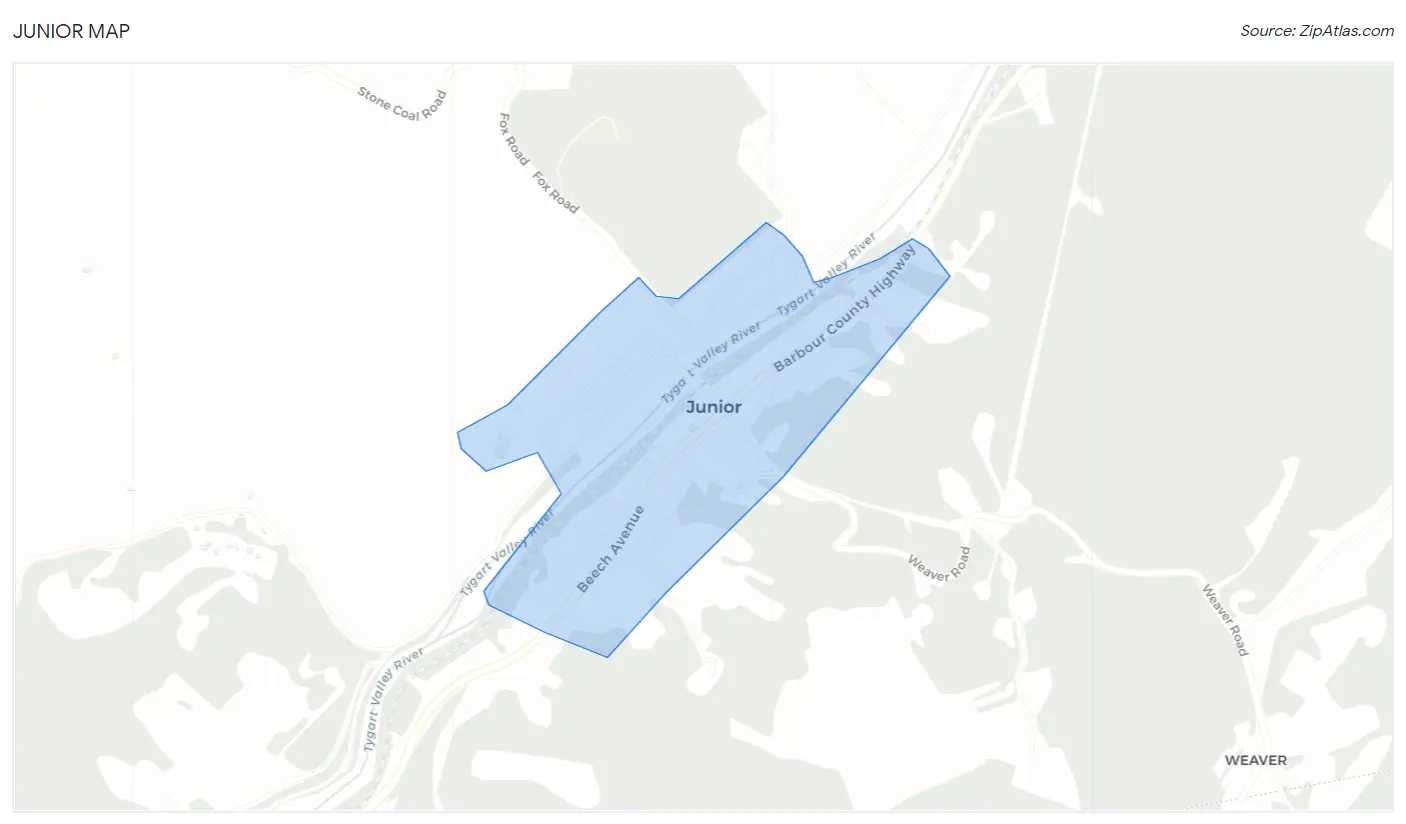
Junior Overview
$13,563
PER CAPITA INCOME
$29,464
AVG FAMILY INCOME
$28,393
AVG HOUSEHOLD INCOME
$9,326
FAMILY INCOME DEFICIT
0.40
INEQUALITY / GINI INDEX
352
TOTAL POPULATION
198
MALE POPULATION
154
FEMALE POPULATION
128.57
MALES / 100 FEMALES
77.78
FEMALES / 100 MALES
43.5
MEDIAN AGE
3.1
AVG FAMILY SIZE
2.7
AVG HOUSEHOLD SIZE
119
LABOR FORCE [ PEOPLE ]
44.6%
PERCENT IN LABOR FORCE
27.7%
UNEMPLOYMENT RATE
Junior Zip Codes
Junior Area Codes
Income in Junior
Income Overview in Junior
Per Capita Income in Junior is $13,563, while median incomes of families and households are $29,464 and $28,393 respectively.
| Characteristic | Number | Measure |
| Per Capita Income | 352 | $13,563 |
| Median Family Income | 97 | $29,464 |
| Mean Family Income | 97 | $34,294 |
| Median Household Income | 131 | $28,393 |
| Mean Household Income | 131 | $32,365 |
| Income Deficit | 97 | $9,326 |
| Wage / Income Gap (%) | 352 | 0.00% |
| Wage / Income Gap ($) | 352 | 100.00¢ per $1 |
| Gini / Inequality Index | 352 | 0.40 |
Earnings by Sex in Junior

| Sex | Number | Average Earnings |
| Male | 63 (63.0%) | $29,306 |
| Female | 37 (37.0%) | $0 |
| Total | 100 (100.0%) | $28,036 |
Earnings by Sex by Income Bracket in Junior
The most common earnings brackets in Junior are $45,000 to $49,999 for men (13 | 20.6%) and $2,499 or less for women (7 | 18.9%).
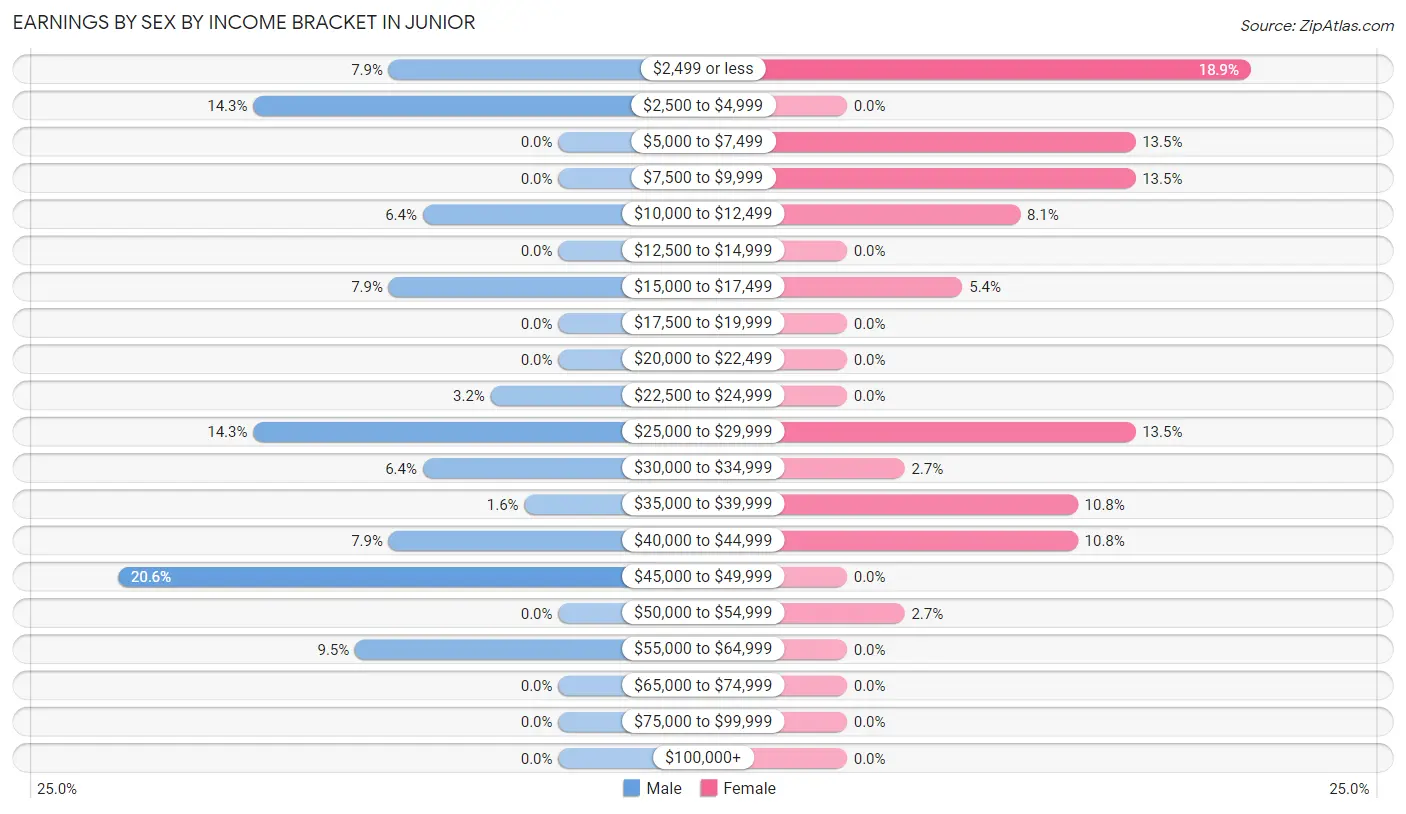
| Income | Male | Female |
| $2,499 or less | 5 (7.9%) | 7 (18.9%) |
| $2,500 to $4,999 | 9 (14.3%) | 0 (0.0%) |
| $5,000 to $7,499 | 0 (0.0%) | 5 (13.5%) |
| $7,500 to $9,999 | 0 (0.0%) | 5 (13.5%) |
| $10,000 to $12,499 | 4 (6.4%) | 3 (8.1%) |
| $12,500 to $14,999 | 0 (0.0%) | 0 (0.0%) |
| $15,000 to $17,499 | 5 (7.9%) | 2 (5.4%) |
| $17,500 to $19,999 | 0 (0.0%) | 0 (0.0%) |
| $20,000 to $22,499 | 0 (0.0%) | 0 (0.0%) |
| $22,500 to $24,999 | 2 (3.2%) | 0 (0.0%) |
| $25,000 to $29,999 | 9 (14.3%) | 5 (13.5%) |
| $30,000 to $34,999 | 4 (6.4%) | 1 (2.7%) |
| $35,000 to $39,999 | 1 (1.6%) | 4 (10.8%) |
| $40,000 to $44,999 | 5 (7.9%) | 4 (10.8%) |
| $45,000 to $49,999 | 13 (20.6%) | 0 (0.0%) |
| $50,000 to $54,999 | 0 (0.0%) | 1 (2.7%) |
| $55,000 to $64,999 | 6 (9.5%) | 0 (0.0%) |
| $65,000 to $74,999 | 0 (0.0%) | 0 (0.0%) |
| $75,000 to $99,999 | 0 (0.0%) | 0 (0.0%) |
| $100,000+ | 0 (0.0%) | 0 (0.0%) |
| Total | 63 (100.0%) | 37 (100.0%) |
Earnings by Sex by Educational Attainment in Junior

| Educational Attainment | Male Income | Female Income |
| Less than High School | - | - |
| High School Diploma | $45,577 | $0 |
| College or Associate's Degree | $28,750 | $0 |
| Bachelor's Degree | - | - |
| Graduate Degree | - | - |
| Total | $40,000 | $0 |
Family Income in Junior
Family Income Brackets in Junior
According to the Junior family income data, there are 21 families falling into the $10,000 to $14,999 income range, which is the most common income bracket and makes up 21.6% of all families.

| Income Bracket | # Families | % Families |
| Less than $10,000 | 7 | 7.2% |
| $10,000 to $14,999 | 21 | 21.6% |
| $15,000 to $24,999 | 11 | 11.3% |
| $25,000 to $34,999 | 19 | 19.6% |
| $35,000 to $49,999 | 11 | 11.3% |
| $50,000 to $74,999 | 19 | 19.6% |
| $75,000 to $99,999 | 9 | 9.3% |
| $100,000 to $149,999 | 0 | 0.0% |
| $150,000 to $199,999 | 0 | 0.0% |
| $200,000+ | 0 | 0.0% |
Family Income by Famaliy Size in Junior
5-person families (8 | 8.3%) account for the highest median family income in Junior with $43,750 per family, while 2-person families (63 | 64.9%) have the highest median income of $16,354 per family member.

| Income Bracket | # Families | Median Income |
| 2-Person Families | 63 (64.9%) | $32,708 |
| 3-Person Families | 15 (15.5%) | $0 |
| 4-Person Families | 4 (4.1%) | $0 |
| 5-Person Families | 8 (8.3%) | $43,750 |
| 6-Person Families | 7 (7.2%) | $0 |
| 7+ Person Families | 0 (0.0%) | $0 |
| Total | 97 (100.0%) | $29,464 |
Family Income by Number of Earners in Junior

| Number of Earners | # Families | Median Income |
| No Earners | 42 (43.3%) | $20,000 |
| 1 Earner | 39 (40.2%) | $32,917 |
| 2 Earners | 12 (12.4%) | $0 |
| 3+ Earners | 4 (4.1%) | $0 |
| Total | 97 (100.0%) | $29,464 |
Household Income in Junior
Household Income Brackets in Junior
With 29 households falling in the category, the $10,000 to $14,999 income range is the most frequent in Junior, accounting for 22.1% of all households.

| Income Bracket | # Households | % Households |
| Less than $10,000 | 13 | 9.9% |
| $10,000 to $14,999 | 29 | 22.1% |
| $15,000 to $24,999 | 17 | 13.0% |
| $25,000 to $34,999 | 20 | 15.3% |
| $35,000 to $49,999 | 17 | 13.0% |
| $50,000 to $74,999 | 26 | 19.8% |
| $75,000 to $99,999 | 9 | 6.9% |
| $100,000 to $149,999 | 0 | 0.0% |
| $150,000 to $199,999 | 0 | 0.0% |
| $200,000+ | 0 | 0.0% |
Household Income by Householder Age in Junior
The median household income in Junior is $28,393, with the highest median household income of $38,750 found in the 65+ years age bracket for the primary householder. A total of 30 households (22.9%) fall into this category.

| Income Bracket | # Households | Median Income |
| 15 to 24 Years | 0 (0.0%) | $0 |
| 25 to 44 Years | 32 (24.4%) | $28,929 |
| 45 to 64 Years | 69 (52.7%) | $0 |
| 65+ Years | 30 (22.9%) | $38,750 |
| Total | 131 (100.0%) | $28,393 |
Poverty in Junior
Income Below Poverty by Sex and Age in Junior
With 43.4% poverty level for males and 52.6% for females among the residents of Junior, 15 year old males and under 5 year old females are the most vulnerable to poverty, with 13 males (100.0%) and 11 females (100.0%) in their respective age groups living below the poverty level.
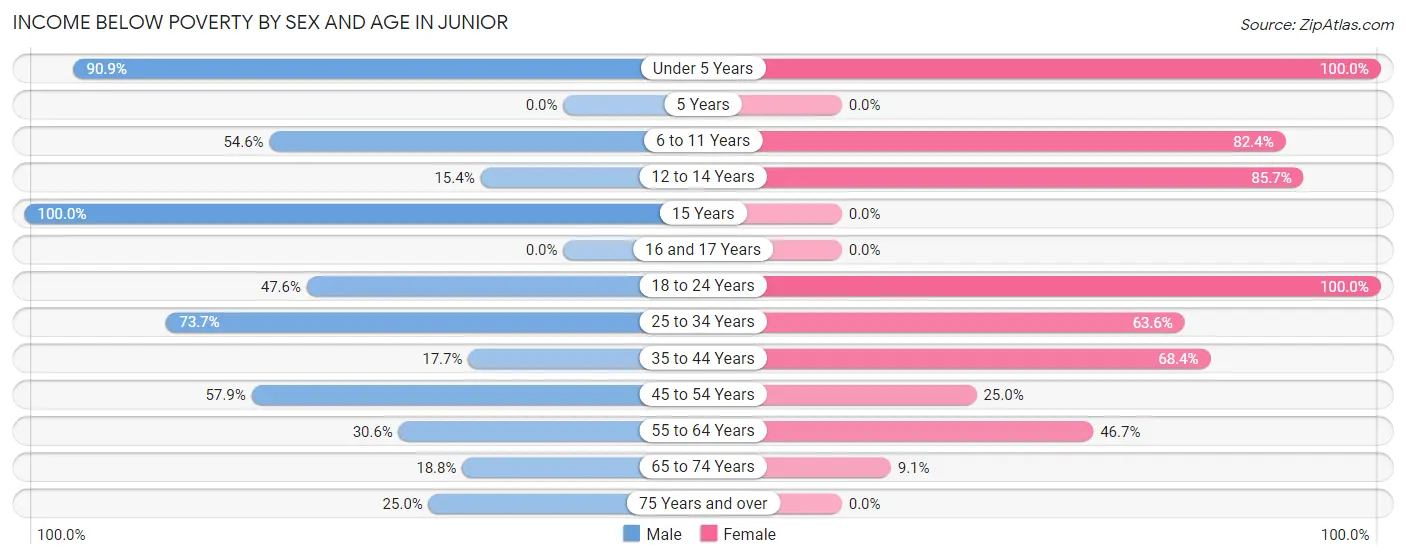
| Age Bracket | Male | Female |
| Under 5 Years | 10 (90.9%) | 11 (100.0%) |
| 5 Years | 0 (0.0%) | 0 (0.0%) |
| 6 to 11 Years | 6 (54.5%) | 14 (82.4%) |
| 12 to 14 Years | 2 (15.4%) | 6 (85.7%) |
| 15 Years | 13 (100.0%) | 0 (0.0%) |
| 16 and 17 Years | 0 (0.0%) | 0 (0.0%) |
| 18 to 24 Years | 10 (47.6%) | 3 (100.0%) |
| 25 to 34 Years | 14 (73.7%) | 7 (63.6%) |
| 35 to 44 Years | 3 (17.6%) | 13 (68.4%) |
| 45 to 54 Years | 11 (57.9%) | 5 (25.0%) |
| 55 to 64 Years | 11 (30.6%) | 21 (46.7%) |
| 65 to 74 Years | 3 (18.8%) | 1 (9.1%) |
| 75 Years and over | 3 (25.0%) | 0 (0.0%) |
| Total | 86 (43.4%) | 81 (52.6%) |
Income Above Poverty by Sex and Age in Junior
According to the poverty statistics in Junior, males aged 16 and 17 years and females aged 15 years are the age groups that are most secure financially, with 100.0% of males and 100.0% of females in these age groups living above the poverty line.
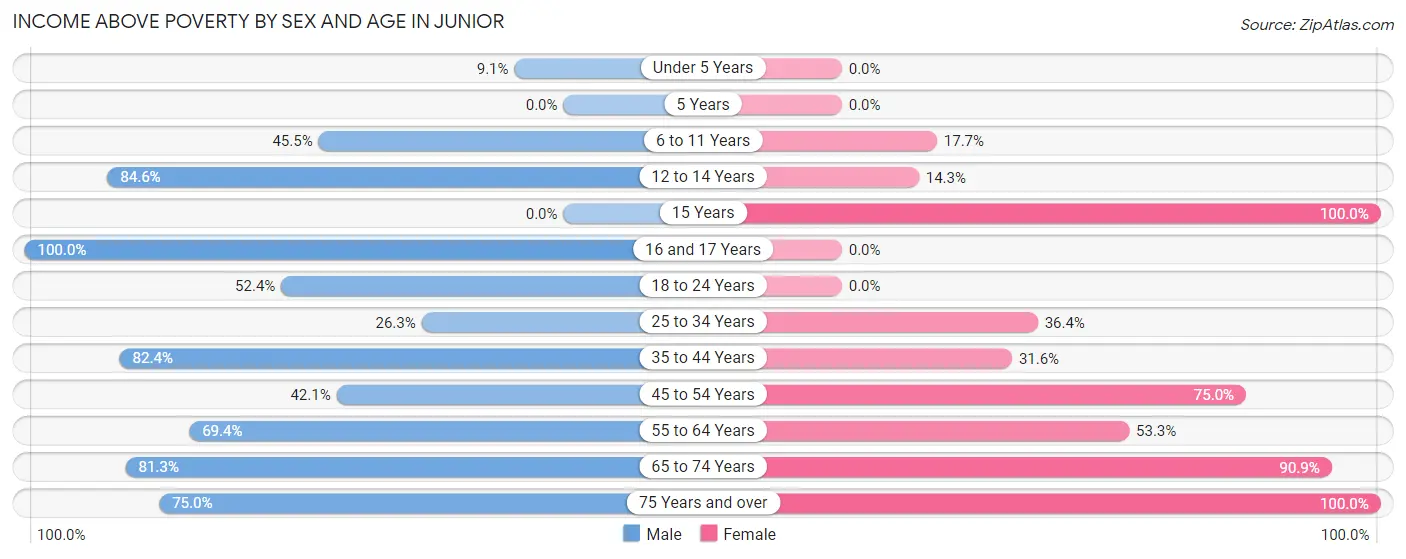
| Age Bracket | Male | Female |
| Under 5 Years | 1 (9.1%) | 0 (0.0%) |
| 5 Years | 0 (0.0%) | 0 (0.0%) |
| 6 to 11 Years | 5 (45.5%) | 3 (17.6%) |
| 12 to 14 Years | 11 (84.6%) | 1 (14.3%) |
| 15 Years | 0 (0.0%) | 2 (100.0%) |
| 16 and 17 Years | 10 (100.0%) | 0 (0.0%) |
| 18 to 24 Years | 11 (52.4%) | 0 (0.0%) |
| 25 to 34 Years | 5 (26.3%) | 4 (36.4%) |
| 35 to 44 Years | 14 (82.4%) | 6 (31.6%) |
| 45 to 54 Years | 8 (42.1%) | 15 (75.0%) |
| 55 to 64 Years | 25 (69.4%) | 24 (53.3%) |
| 65 to 74 Years | 13 (81.2%) | 10 (90.9%) |
| 75 Years and over | 9 (75.0%) | 8 (100.0%) |
| Total | 112 (56.6%) | 73 (47.4%) |
Income Below Poverty Among Married-Couple Families in Junior
The poverty statistics for married-couple families in Junior show that 20.7% or 12 of the total 58 families live below the poverty line. Families with 3 or 4 children have the highest poverty rate of 81.8%, comprising of 9 families. On the other hand, families with 1 or 2 children have the lowest poverty rate of 0.0%, which includes 0 families.

| Children | Above Poverty | Below Poverty |
| No Children | 36 (92.3%) | 3 (7.7%) |
| 1 or 2 Children | 8 (100.0%) | 0 (0.0%) |
| 3 or 4 Children | 2 (18.2%) | 9 (81.8%) |
| 5 or more Children | 0 (0.0%) | 0 (0.0%) |
| Total | 46 (79.3%) | 12 (20.7%) |
Income Below Poverty Among Single-Parent Households in Junior

| Children | Single Father | Single Mother |
| No Children | 0 (0.0%) | 5 (50.0%) |
| 1 or 2 Children | 0 (0.0%) | 25 (86.2%) |
| 3 or 4 Children | 0 (0.0%) | 0 (0.0%) |
| 5 or more Children | 0 (0.0%) | 0 (0.0%) |
| Total | 0 (0.0%) | 30 (76.9%) |
Income Below Poverty Among Married-Couple vs Single-Parent Households in Junior
The poverty data for Junior shows that 12 of the married-couple family households (20.7%) and 30 of the single-parent households (76.9%) are living below the poverty level. Within the married-couple family households, those with 3 or 4 children have the highest poverty rate, with 9 households (81.8%) falling below the poverty line. Among the single-parent households, those with 1 or 2 children have the highest poverty rate, with 25 household (86.2%) living below poverty.

| Children | Married-Couple Families | Single-Parent Households |
| No Children | 3 (7.7%) | 5 (50.0%) |
| 1 or 2 Children | 0 (0.0%) | 25 (86.2%) |
| 3 or 4 Children | 9 (81.8%) | 0 (0.0%) |
| 5 or more Children | 0 (0.0%) | 0 (0.0%) |
| Total | 12 (20.7%) | 30 (76.9%) |
Race in Junior
The most populous races in Junior are White / Caucasian (321 | 91.2%), Two or more Races (28 | 8.0%), and Black / African American (3 | 0.9%).

| Race | # Population | % Population |
| Asian | 0 | 0.0% |
| Black / African American | 3 | 0.9% |
| Hawaiian / Pacific | 0 | 0.0% |
| Hispanic or Latino | 0 | 0.0% |
| Native / Alaskan | 0 | 0.0% |
| White / Caucasian | 321 | 91.2% |
| Two or more Races | 28 | 8.0% |
| Some other Race | 0 | 0.0% |
| Total | 352 | 100.0% |
Ancestry in Junior
The most populous ancestries reported in Junior are Irish (66 | 18.8%), German (33 | 9.4%), Scottish (28 | 8.0%), American (24 | 6.8%), and English (21 | 6.0%), together accounting for 48.9% of all Junior residents.
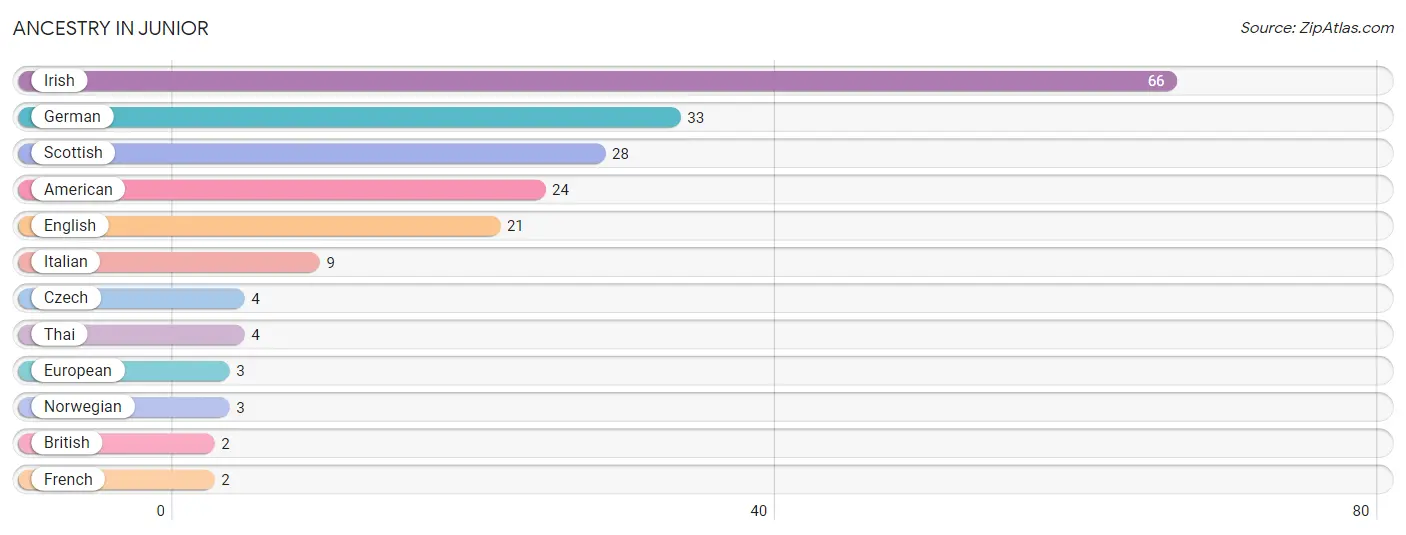
| Ancestry | # Population | % Population |
| American | 24 | 6.8% |
| British | 2 | 0.6% |
| Czech | 4 | 1.1% |
| English | 21 | 6.0% |
| European | 3 | 0.9% |
| French | 2 | 0.6% |
| German | 33 | 9.4% |
| Irish | 66 | 18.8% |
| Italian | 9 | 2.6% |
| Norwegian | 3 | 0.9% |
| Scottish | 28 | 8.0% |
| Thai | 4 | 1.1% | View All 12 Rows |
Immigrants in Junior

| Immigration Origin | # Population | % Population | View All 0 Rows |
Sex and Age in Junior
Sex and Age in Junior
The most populous age groups in Junior are 60 to 64 Years (35 | 17.7%) for men and 60 to 64 Years (24 | 15.6%) for women.
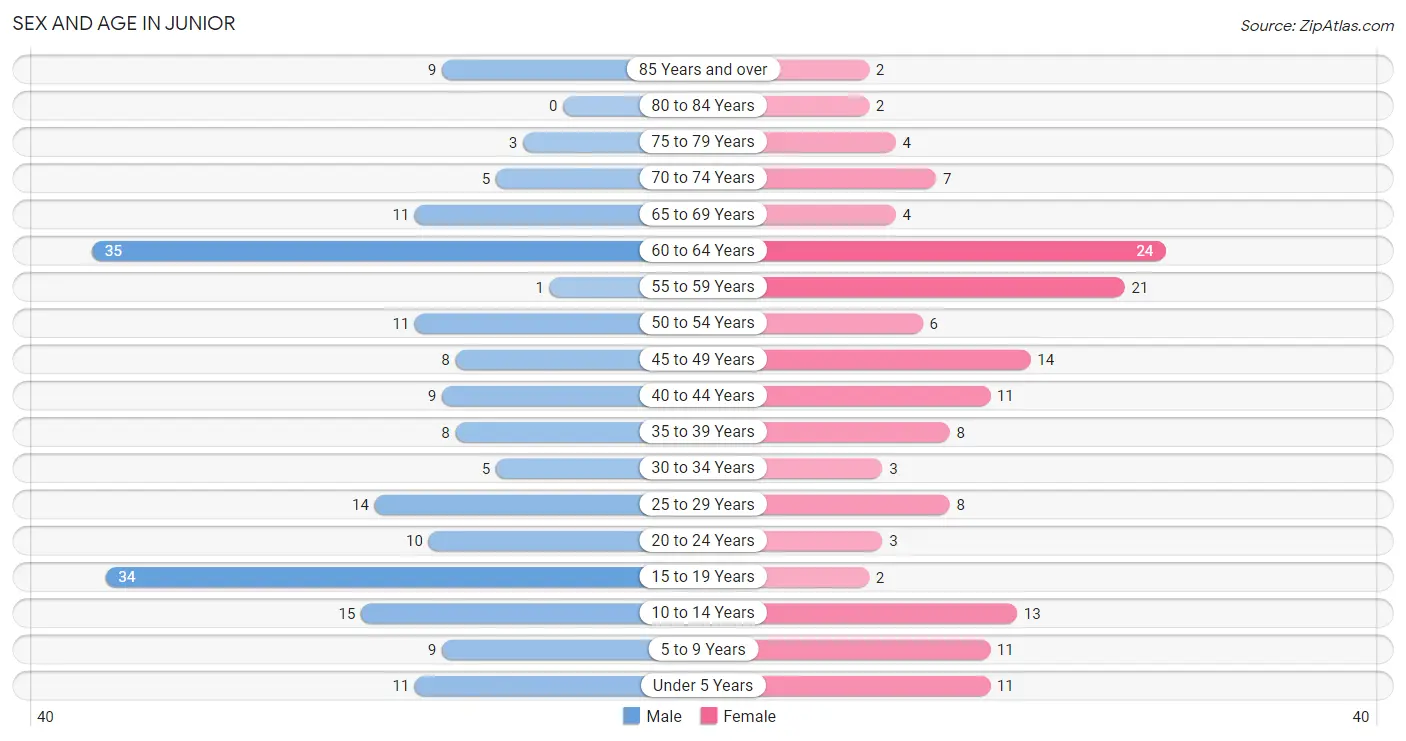
| Age Bracket | Male | Female |
| Under 5 Years | 11 (5.6%) | 11 (7.1%) |
| 5 to 9 Years | 9 (4.5%) | 11 (7.1%) |
| 10 to 14 Years | 15 (7.6%) | 13 (8.4%) |
| 15 to 19 Years | 34 (17.2%) | 2 (1.3%) |
| 20 to 24 Years | 10 (5.1%) | 3 (1.9%) |
| 25 to 29 Years | 14 (7.1%) | 8 (5.2%) |
| 30 to 34 Years | 5 (2.5%) | 3 (1.9%) |
| 35 to 39 Years | 8 (4.0%) | 8 (5.2%) |
| 40 to 44 Years | 9 (4.5%) | 11 (7.1%) |
| 45 to 49 Years | 8 (4.0%) | 14 (9.1%) |
| 50 to 54 Years | 11 (5.6%) | 6 (3.9%) |
| 55 to 59 Years | 1 (0.5%) | 21 (13.6%) |
| 60 to 64 Years | 35 (17.7%) | 24 (15.6%) |
| 65 to 69 Years | 11 (5.6%) | 4 (2.6%) |
| 70 to 74 Years | 5 (2.5%) | 7 (4.5%) |
| 75 to 79 Years | 3 (1.5%) | 4 (2.6%) |
| 80 to 84 Years | 0 (0.0%) | 2 (1.3%) |
| 85 Years and over | 9 (4.5%) | 2 (1.3%) |
| Total | 198 (100.0%) | 154 (100.0%) |
Families and Households in Junior
Median Family Size in Junior

| Family Type | # Families | Family Size |
| Married-Couple | 58 (59.8%) | 3.74 |
| Single Male/Father | 0 (0.0%) | - |
| Single Female/Mother | 39 (40.2%) | 2.28 |
| Total Families | 97 (100.0%) | 3.15 |
Median Household Size in Junior

| Household Type | # Households | Household Size |
| Married-Couple | 58 (44.3%) | 3.79 |
| Single Male/Father | 0 (0.0%) | - |
| Single Female/Mother | 39 (29.8%) | 2.38 |
| Non-family | 34 (26.0%) | 1.15 |
| Total Households | 131 (100.0%) | 2.69 |
Household Size by Marriage Status in Junior
Out of a total of 131 households in Junior, 97 (74.1%) are family households, while 34 (26.0%) are nonfamily households. The most numerous type of family households are 2-person households, comprising 63, and the most common type of nonfamily households are 1-person households, comprising 31.

| Household Size | Family Households | Nonfamily Households |
| 1-Person Households | - | 31 (23.7%) |
| 2-Person Households | 63 (48.1%) | 3 (2.3%) |
| 3-Person Households | 5 (3.8%) | 0 (0.0%) |
| 4-Person Households | 14 (10.7%) | 0 (0.0%) |
| 5-Person Households | 8 (6.1%) | 0 (0.0%) |
| 6-Person Households | 7 (5.3%) | 0 (0.0%) |
| 7+ Person Households | 0 (0.0%) | 0 (0.0%) |
| Total | 97 (74.1%) | 34 (26.0%) |
Female Fertility in Junior
Fertility by Age in Junior
Average fertility rate in Junior is 143.0 births per 1,000 women. Women in the age bracket of 20 to 34 years have the highest fertility rate with 500.0 births per 1,000 women. Women in the age bracket of 20 to 34 years acount for 100.0% of all women with births.

| Age Bracket | Women with Births | Births / 1,000 Women |
| 15 to 19 years | 0 (0.0%) | 0.0 |
| 20 to 34 years | 7 (100.0%) | 500.0 |
| 35 to 50 years | 0 (0.0%) | 0.0 |
| Total | 7 (100.0%) | 143.0 |
Fertility by Age by Marriage Status in Junior

| Age Bracket | Married | Unmarried |
| 15 to 19 years | 0 (0.0%) | 0 (0.0%) |
| 20 to 34 years | 0 (0.0%) | 7 (100.0%) |
| 35 to 50 years | 0 (0.0%) | 0 (0.0%) |
| Total | 0 (0.0%) | 7 (100.0%) |
Fertility by Education in Junior
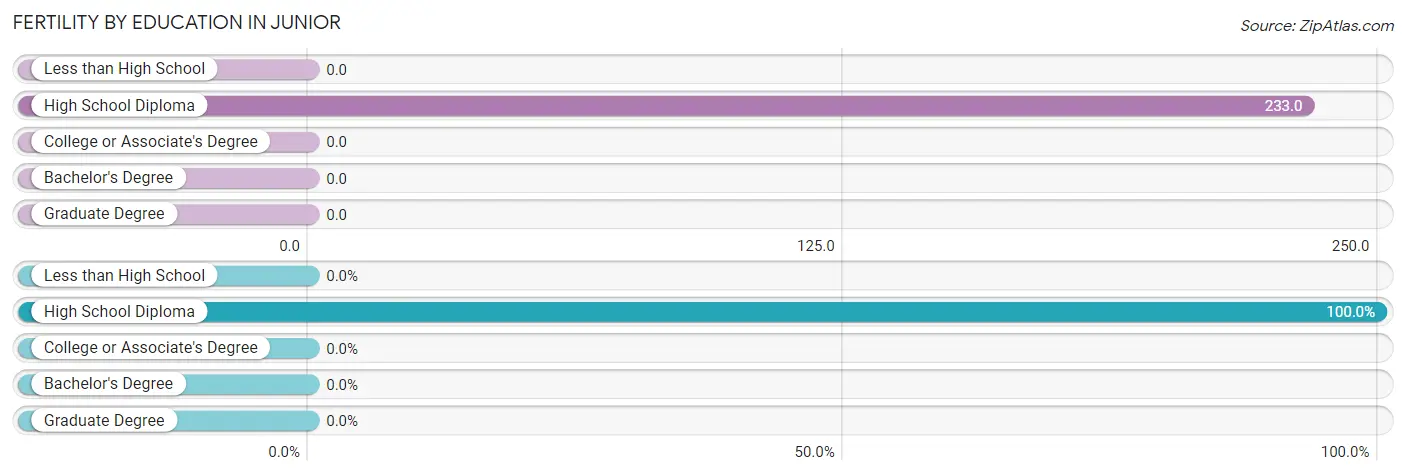
| Educational Attainment | Women with Births | Births / 1,000 Women |
| Less than High School | 0 (0.0%) | 0.0 |
| High School Diploma | 7 (100.0%) | 233.0 |
| College or Associate's Degree | 0 (0.0%) | 0.0 |
| Bachelor's Degree | 0 (0.0%) | 0.0 |
| Graduate Degree | 0 (0.0%) | 0.0 |
| Total | 7 (100.0%) | 143.0 |
Fertility by Education by Marriage Status in Junior

| Educational Attainment | Married | Unmarried |
| Less than High School | 0 (0.0%) | 0 (0.0%) |
| High School Diploma | 0 (0.0%) | 7 (100.0%) |
| College or Associate's Degree | 0 (0.0%) | 0 (0.0%) |
| Bachelor's Degree | 0 (0.0%) | 0 (0.0%) |
| Graduate Degree | 0 (0.0%) | 0 (0.0%) |
| Total | 0 (0.0%) | 7 (100.0%) |
Employment Characteristics in Junior
Employment by Class of Employer in Junior
Among the 86 employed individuals in Junior, private company employees (60 | 69.8%), local government employees (8 | 9.3%), and not-for-profit organizations (7 | 8.1%) make up the most common classes of employment.

| Employer Class | # Employees | % Employees |
| Private Company Employees | 60 | 69.8% |
| Self-Employed (Incorporated) | 3 | 3.5% |
| Self-Employed (Not Incorporated) | 6 | 7.0% |
| Not-for-profit Organizations | 7 | 8.1% |
| Local Government Employees | 8 | 9.3% |
| State Government Employees | 0 | 0.0% |
| Federal Government Employees | 0 | 0.0% |
| Unpaid Family Workers | 2 | 2.3% |
| Total | 86 | 100.0% |
Employment Status by Age in Junior
According to the labor force statistics for Junior, out of the total population over 16 years of age (267), 44.6% or 119 individuals are in the labor force, with 27.7% or 33 of them unemployed. The age group with the highest labor force participation rate is 20 to 24 years, with 100.0% or 13 individuals in the labor force. Within the labor force, the 60 to 64 years age range has the highest percentage of unemployed individuals, with 50.0% or 11 of them being unemployed.

| Age Bracket | In Labor Force | Unemployed |
| 16 to 19 Years | 8 (38.1%) | 3 (37.5%) |
| 20 to 24 Years | 13 (100.0%) | 6 (46.2%) |
| 25 to 29 Years | 11 (50.0%) | 3 (27.3%) |
| 30 to 34 Years | 5 (62.5%) | 0 (0.0%) |
| 35 to 44 Years | 26 (72.2%) | 2 (7.7%) |
| 45 to 54 Years | 31 (79.5%) | 8 (25.8%) |
| 55 to 59 Years | 3 (13.6%) | 0 (0.0%) |
| 60 to 64 Years | 22 (37.3%) | 11 (50.0%) |
| 65 to 74 Years | 0 (0.0%) | 0 (0.0%) |
| 75 Years and over | 0 (0.0%) | 0 (0.0%) |
| Total | 119 (44.6%) | 33 (27.7%) |
Employment Status by Educational Attainment in Junior
According to labor force statistics for Junior, 52.7% of individuals (98) out of the total population between 25 and 64 years of age (186) are in the labor force, with 24.5% or 24 of them being unemployed. The group with the highest labor force participation rate are those with the educational attainment of bachelor's degree or higher, with 100.0% or 4 individuals in the labor force. Within the labor force, individuals with less than high school education have the highest percentage of unemployment, with 53.3% or 8 of them being unemployed.

| Educational Attainment | In Labor Force | Unemployed |
| Less than High School | 15 (48.4%) | 17 (53.3%) |
| High School Diploma | 68 (54.0%) | 30 (23.5%) |
| College / Associate Degree | 11 (44.0%) | 0 (0.0%) |
| Bachelor's Degree or higher | 4 (100.0%) | 0 (0.0%) |
| Total | 98 (52.7%) | 46 (24.5%) |
Employment Occupations by Sex in Junior
Management, Business, Science and Arts Occupations
The most common Management, Business, Science and Arts occupations in Junior are Health Diagnosing & Treating (4 | 4.6%), Community & Social Service (2 | 2.3%), Computers, Engineering & Science (1 | 1.2%), Life, Physical & Social Science (1 | 1.2%), and Education, Arts & Media (1 | 1.2%).
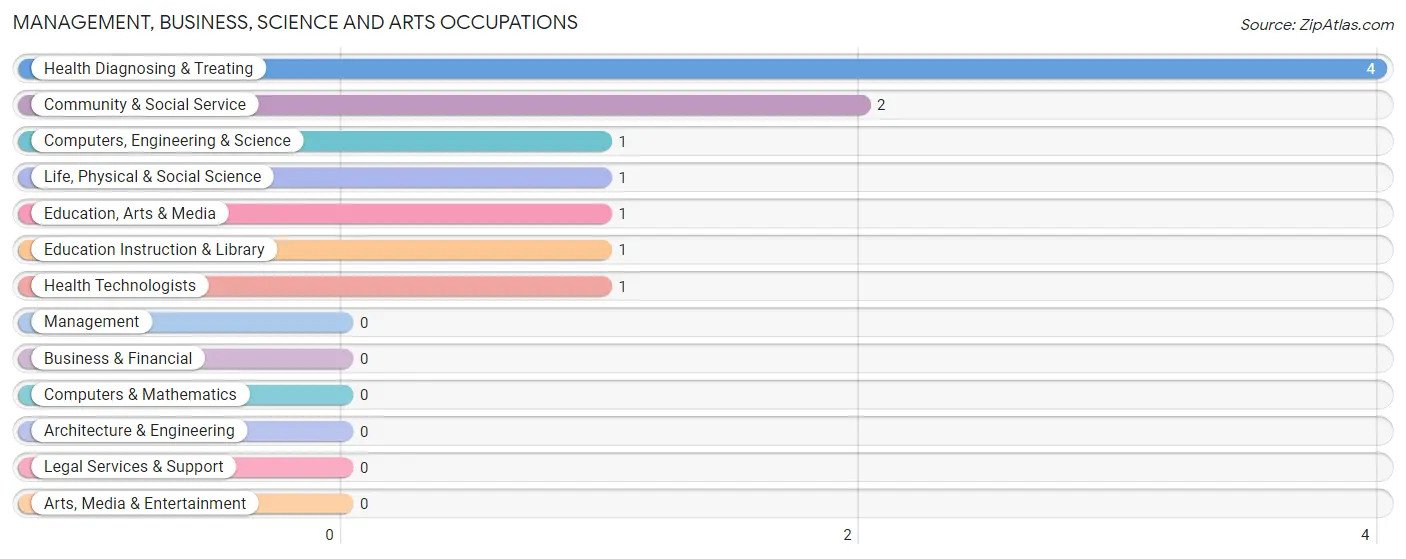
Management, Business, Science and Arts Occupations by Sex
Within the Management, Business, Science and Arts occupations in Junior, the most male-oriented occupations are Computers, Engineering & Science (100.0%), Life, Physical & Social Science (100.0%), and Education, Arts & Media (100.0%), while the most female-oriented occupations are Education Instruction & Library (100.0%), Health Technologists (100.0%), and Community & Social Service (50.0%).
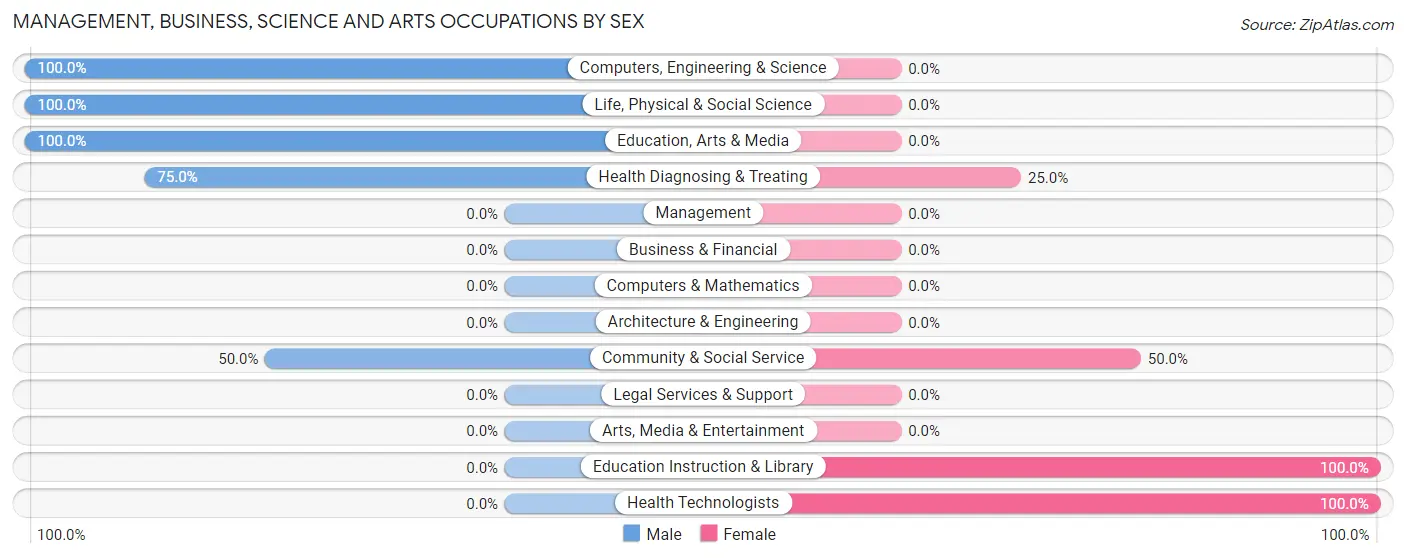
| Occupation | Male | Female |
| Management | 0 (0.0%) | 0 (0.0%) |
| Business & Financial | 0 (0.0%) | 0 (0.0%) |
| Computers, Engineering & Science | 1 (100.0%) | 0 (0.0%) |
| Computers & Mathematics | 0 (0.0%) | 0 (0.0%) |
| Architecture & Engineering | 0 (0.0%) | 0 (0.0%) |
| Life, Physical & Social Science | 1 (100.0%) | 0 (0.0%) |
| Community & Social Service | 1 (50.0%) | 1 (50.0%) |
| Education, Arts & Media | 1 (100.0%) | 0 (0.0%) |
| Legal Services & Support | 0 (0.0%) | 0 (0.0%) |
| Education Instruction & Library | 0 (0.0%) | 1 (100.0%) |
| Arts, Media & Entertainment | 0 (0.0%) | 0 (0.0%) |
| Health Diagnosing & Treating | 3 (75.0%) | 1 (25.0%) |
| Health Technologists | 0 (0.0%) | 1 (100.0%) |
| Total (Category) | 5 (71.4%) | 2 (28.6%) |
| Total (Overall) | 49 (57.0%) | 37 (43.0%) |
Services Occupations
The most common Services occupations in Junior are Food Preparation & Serving (12 | 14.0%), Cleaning & Maintenance (9 | 10.5%), Security & Protection (4 | 4.6%), Law Enforcement (4 | 4.6%), and Healthcare Support (2 | 2.3%).

Services Occupations by Sex
Within the Services occupations in Junior, the most male-oriented occupations are Security & Protection (100.0%), Law Enforcement (100.0%), and Food Preparation & Serving (75.0%), while the most female-oriented occupations are Healthcare Support (100.0%), Personal Care & Service (100.0%), and Cleaning & Maintenance (33.3%).

| Occupation | Male | Female |
| Healthcare Support | 0 (0.0%) | 2 (100.0%) |
| Security & Protection | 4 (100.0%) | 0 (0.0%) |
| Firefighting & Prevention | 0 (0.0%) | 0 (0.0%) |
| Law Enforcement | 4 (100.0%) | 0 (0.0%) |
| Food Preparation & Serving | 9 (75.0%) | 3 (25.0%) |
| Cleaning & Maintenance | 6 (66.7%) | 3 (33.3%) |
| Personal Care & Service | 0 (0.0%) | 1 (100.0%) |
| Total (Category) | 19 (67.9%) | 9 (32.1%) |
| Total (Overall) | 49 (57.0%) | 37 (43.0%) |
Sales and Office Occupations
The most common Sales and Office occupations in Junior are Sales & Related (15 | 17.4%), and Office & Administration (14 | 16.3%).

Sales and Office Occupations by Sex

| Occupation | Male | Female |
| Sales & Related | 0 (0.0%) | 15 (100.0%) |
| Office & Administration | 3 (21.4%) | 11 (78.6%) |
| Total (Category) | 3 (10.3%) | 26 (89.7%) |
| Total (Overall) | 49 (57.0%) | 37 (43.0%) |
Natural Resources, Construction and Maintenance Occupations
The most common Natural Resources, Construction and Maintenance occupations in Junior are Construction & Extraction (5 | 5.8%), and Installation, Maintenance & Repair (5 | 5.8%).

Natural Resources, Construction and Maintenance Occupations by Sex

| Occupation | Male | Female |
| Farming, Fishing & Forestry | 0 (0.0%) | 0 (0.0%) |
| Construction & Extraction | 5 (100.0%) | 0 (0.0%) |
| Installation, Maintenance & Repair | 5 (100.0%) | 0 (0.0%) |
| Total (Category) | 10 (100.0%) | 0 (0.0%) |
| Total (Overall) | 49 (57.0%) | 37 (43.0%) |
Production, Transportation and Moving Occupations
The most common Production, Transportation and Moving occupations in Junior are Transportation (8 | 9.3%), and Production (4 | 4.6%).

Production, Transportation and Moving Occupations by Sex

| Occupation | Male | Female |
| Production | 4 (100.0%) | 0 (0.0%) |
| Transportation | 8 (100.0%) | 0 (0.0%) |
| Material Moving | 0 (0.0%) | 0 (0.0%) |
| Total (Category) | 12 (100.0%) | 0 (0.0%) |
| Total (Overall) | 49 (57.0%) | 37 (43.0%) |
Employment Industries by Sex in Junior
Employment Industries in Junior
The major employment industries in Junior include Accommodation & Food Services (21 | 24.4%), Construction (12 | 14.0%), Retail Trade (12 | 14.0%), Health Care & Social Assistance (11 | 12.8%), and Public Administration (6 | 7.0%).
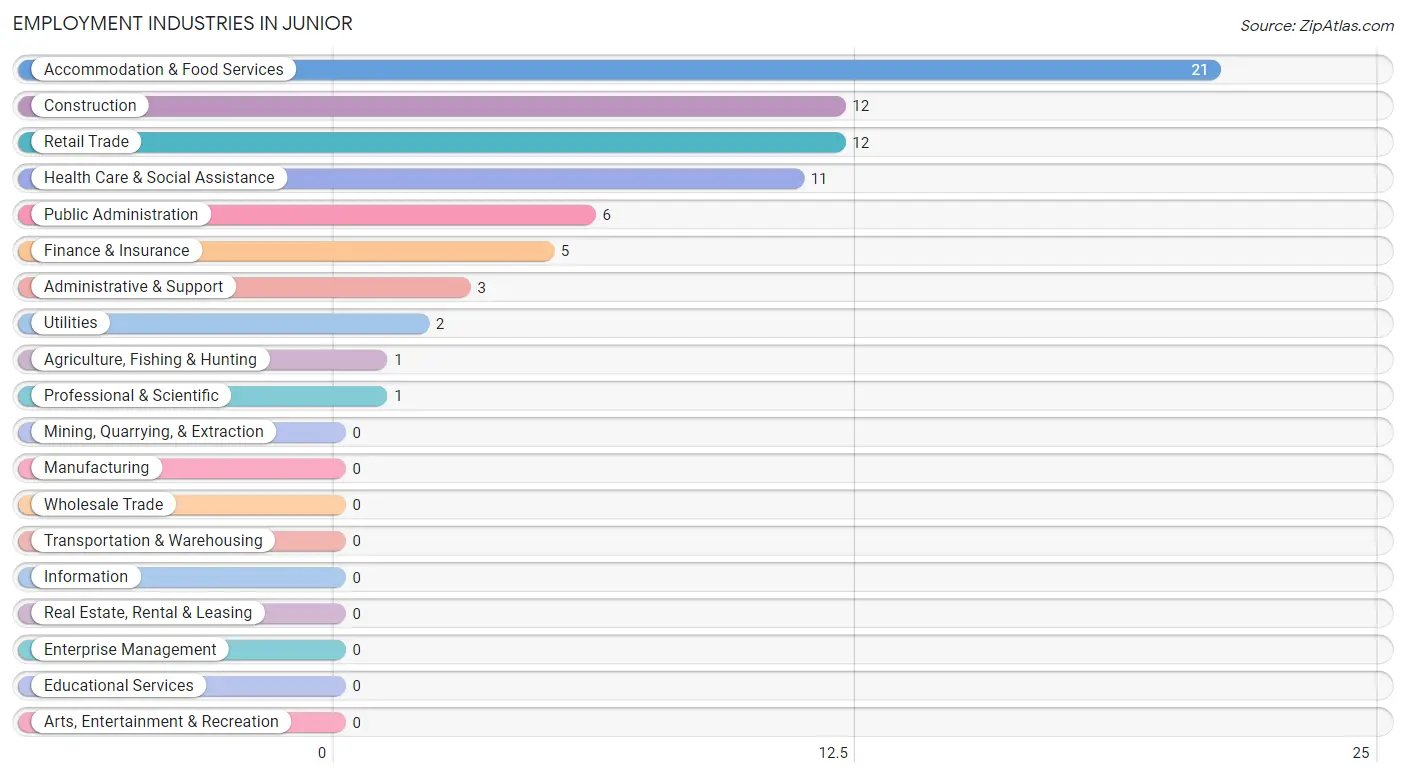
Employment Industries by Sex in Junior
The Junior industries that see more men than women are Agriculture, Fishing & Hunting (100.0%), Construction (100.0%), and Utilities (100.0%), whereas the industries that tend to have a higher number of women are Administrative & Support (100.0%), Health Care & Social Assistance (63.6%), and Accommodation & Food Services (57.1%).
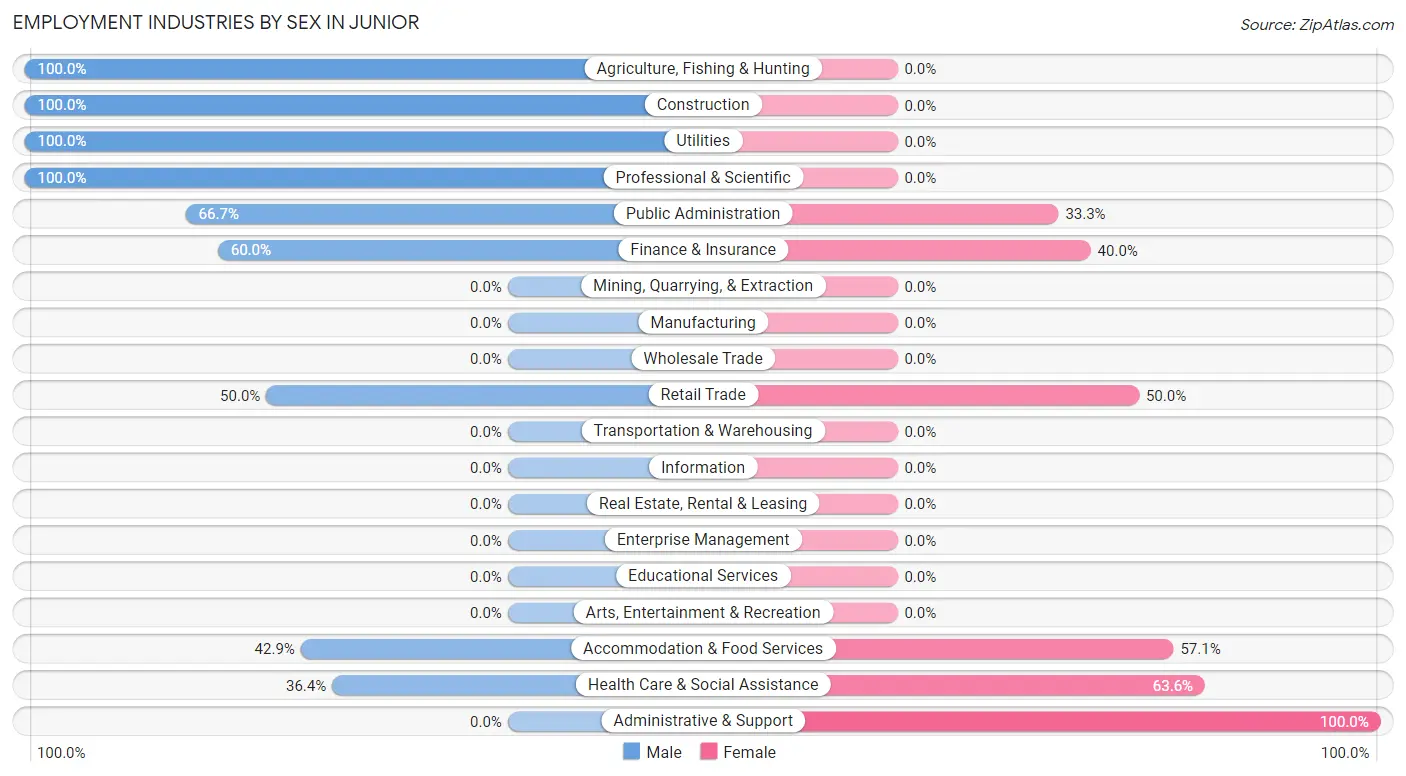
| Industry | Male | Female |
| Agriculture, Fishing & Hunting | 1 (100.0%) | 0 (0.0%) |
| Mining, Quarrying, & Extraction | 0 (0.0%) | 0 (0.0%) |
| Construction | 12 (100.0%) | 0 (0.0%) |
| Manufacturing | 0 (0.0%) | 0 (0.0%) |
| Wholesale Trade | 0 (0.0%) | 0 (0.0%) |
| Retail Trade | 6 (50.0%) | 6 (50.0%) |
| Transportation & Warehousing | 0 (0.0%) | 0 (0.0%) |
| Utilities | 2 (100.0%) | 0 (0.0%) |
| Information | 0 (0.0%) | 0 (0.0%) |
| Finance & Insurance | 3 (60.0%) | 2 (40.0%) |
| Real Estate, Rental & Leasing | 0 (0.0%) | 0 (0.0%) |
| Professional & Scientific | 1 (100.0%) | 0 (0.0%) |
| Enterprise Management | 0 (0.0%) | 0 (0.0%) |
| Administrative & Support | 0 (0.0%) | 3 (100.0%) |
| Educational Services | 0 (0.0%) | 0 (0.0%) |
| Health Care & Social Assistance | 4 (36.4%) | 7 (63.6%) |
| Arts, Entertainment & Recreation | 0 (0.0%) | 0 (0.0%) |
| Accommodation & Food Services | 9 (42.9%) | 12 (57.1%) |
| Public Administration | 4 (66.7%) | 2 (33.3%) |
| Total | 49 (57.0%) | 37 (43.0%) |
Education in Junior
School Enrollment in Junior
The most common levels of schooling among the 76 students in Junior are high school (28 | 36.8%), middle school (25 | 32.9%), and elementary school (22 | 28.9%).

| School Level | # Students | % Students |
| Nursery / Preschool | 1 | 1.3% |
| Kindergarten | 0 | 0.0% |
| Elementary School | 22 | 28.9% |
| Middle School | 25 | 32.9% |
| High School | 28 | 36.8% |
| College / Undergraduate | 0 | 0.0% |
| Graduate / Professional | 0 | 0.0% |
| Total | 76 | 100.0% |
School Enrollment by Age by Funding Source in Junior

| Age Bracket | Public School | Private School |
| 3 to 4 Year Olds | 1 (100.0%) | 0 (0.0%) |
| 5 to 9 Year Old | 20 (100.0%) | 0 (0.0%) |
| 10 to 14 Year Olds | 28 (100.0%) | 0 (0.0%) |
| 15 to 17 Year Olds | 25 (100.0%) | 0 (0.0%) |
| 18 to 19 Year Olds | 2 (100.0%) | 0 (0.0%) |
| 20 to 24 Year Olds | 0 (0.0%) | 0 (0.0%) |
| 25 to 34 Year Olds | 0 (0.0%) | 0 (0.0%) |
| 35 Years and over | 0 (0.0%) | 0 (0.0%) |
| Total | 76 (100.0%) | 0 (0.0%) |
Educational Attainment by Field of Study in Junior
Business (4 | 50.0%), bio, nature & agricultural (2 | 25.0%), and physical & health sciences (2 | 25.0%) are the most common fields of study among 8 individuals in Junior who have obtained a bachelor's degree or higher.
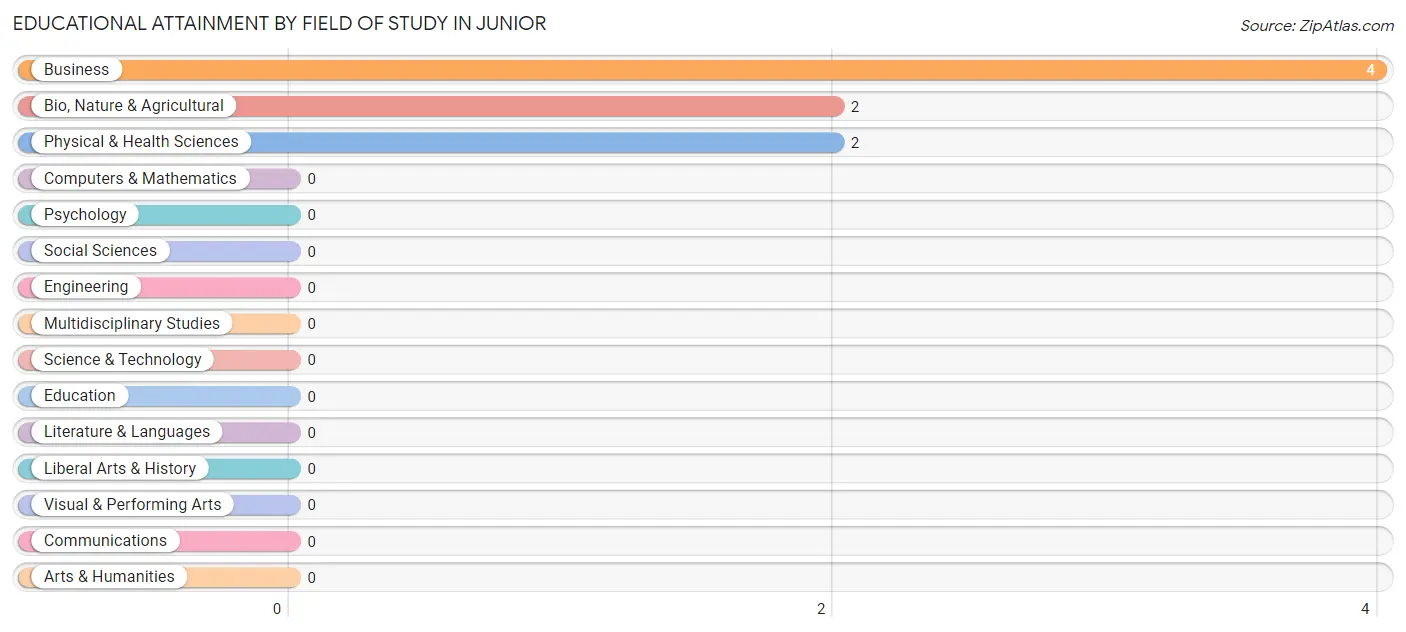
| Field of Study | # Graduates | % Graduates |
| Computers & Mathematics | 0 | 0.0% |
| Bio, Nature & Agricultural | 2 | 25.0% |
| Physical & Health Sciences | 2 | 25.0% |
| Psychology | 0 | 0.0% |
| Social Sciences | 0 | 0.0% |
| Engineering | 0 | 0.0% |
| Multidisciplinary Studies | 0 | 0.0% |
| Science & Technology | 0 | 0.0% |
| Business | 4 | 50.0% |
| Education | 0 | 0.0% |
| Literature & Languages | 0 | 0.0% |
| Liberal Arts & History | 0 | 0.0% |
| Visual & Performing Arts | 0 | 0.0% |
| Communications | 0 | 0.0% |
| Arts & Humanities | 0 | 0.0% |
| Total | 8 | 100.0% |
Transportation & Commute in Junior
Vehicle Availability by Sex in Junior
The most prevalent vehicle ownership categories in Junior are males with 2 vehicles (19, accounting for 38.8%) and females with 2 vehicles (6, making up 51.3%).

| Vehicles Available | Male | Female |
| No Vehicle | 0 (0.0%) | 3 (8.1%) |
| 1 Vehicle | 11 (22.5%) | 12 (32.4%) |
| 2 Vehicles | 19 (38.8%) | 6 (16.2%) |
| 3 Vehicles | 15 (30.6%) | 10 (27.0%) |
| 4 Vehicles | 4 (8.2%) | 6 (16.2%) |
| 5 or more Vehicles | 0 (0.0%) | 0 (0.0%) |
| Total | 49 (100.0%) | 37 (100.0%) |
Commute Time in Junior
The most frequently occuring commute durations in Junior are 25 to 29 minutes (25 commuters, 29.1%), 15 to 19 minutes (22 commuters, 25.6%), and 5 to 9 minutes (11 commuters, 12.8%).
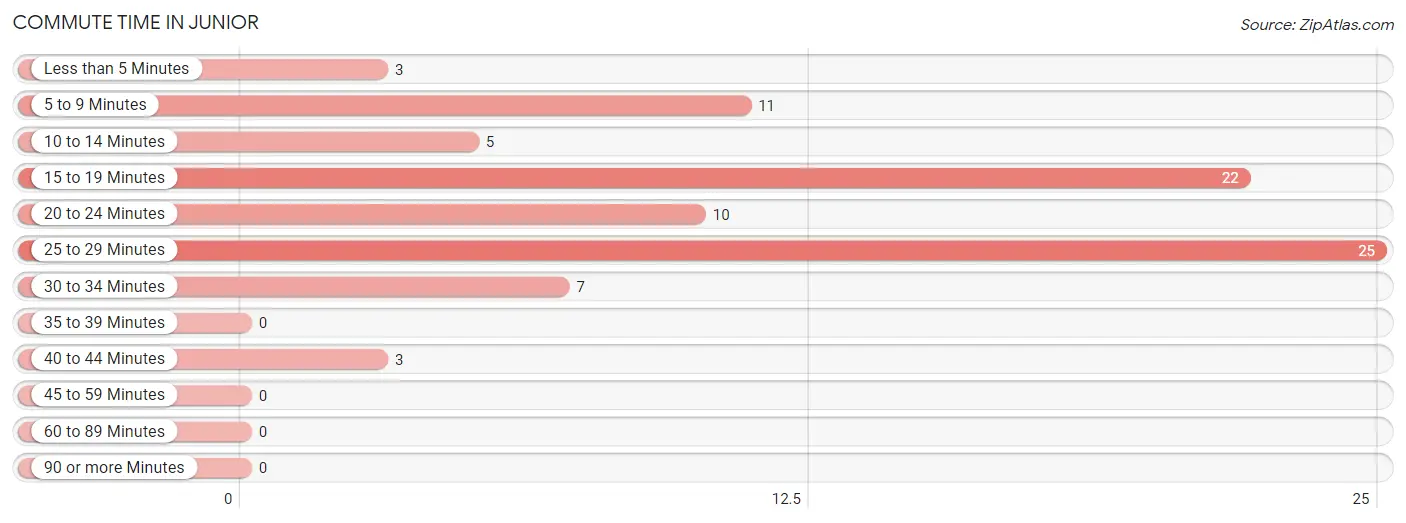
| Commute Time | # Commuters | % Commuters |
| Less than 5 Minutes | 3 | 3.5% |
| 5 to 9 Minutes | 11 | 12.8% |
| 10 to 14 Minutes | 5 | 5.8% |
| 15 to 19 Minutes | 22 | 25.6% |
| 20 to 24 Minutes | 10 | 11.6% |
| 25 to 29 Minutes | 25 | 29.1% |
| 30 to 34 Minutes | 7 | 8.1% |
| 35 to 39 Minutes | 0 | 0.0% |
| 40 to 44 Minutes | 3 | 3.5% |
| 45 to 59 Minutes | 0 | 0.0% |
| 60 to 89 Minutes | 0 | 0.0% |
| 90 or more Minutes | 0 | 0.0% |
Commute Time by Sex in Junior
The most common commute times in Junior are 15 to 19 minutes (13 commuters, 26.5%) for males and 25 to 29 minutes (12 commuters, 32.4%) for females.
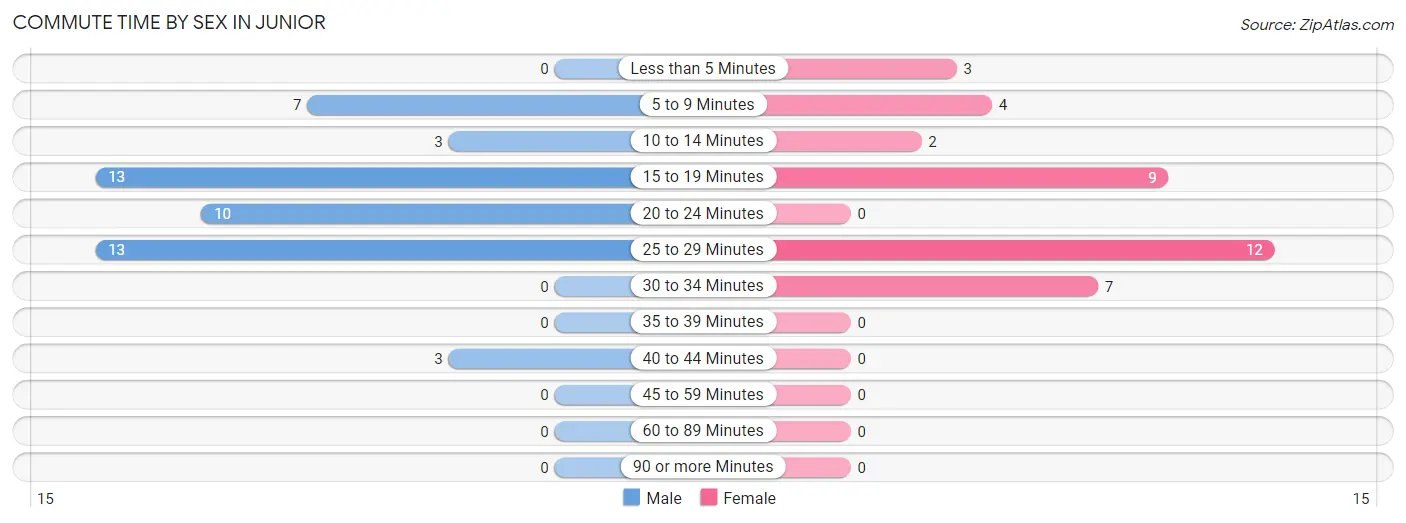
| Commute Time | Male | Female |
| Less than 5 Minutes | 0 (0.0%) | 3 (8.1%) |
| 5 to 9 Minutes | 7 (14.3%) | 4 (10.8%) |
| 10 to 14 Minutes | 3 (6.1%) | 2 (5.4%) |
| 15 to 19 Minutes | 13 (26.5%) | 9 (24.3%) |
| 20 to 24 Minutes | 10 (20.4%) | 0 (0.0%) |
| 25 to 29 Minutes | 13 (26.5%) | 12 (32.4%) |
| 30 to 34 Minutes | 0 (0.0%) | 7 (18.9%) |
| 35 to 39 Minutes | 0 (0.0%) | 0 (0.0%) |
| 40 to 44 Minutes | 3 (6.1%) | 0 (0.0%) |
| 45 to 59 Minutes | 0 (0.0%) | 0 (0.0%) |
| 60 to 89 Minutes | 0 (0.0%) | 0 (0.0%) |
| 90 or more Minutes | 0 (0.0%) | 0 (0.0%) |
Time of Departure to Work by Sex in Junior
The most frequent times of departure to work in Junior are 4:00 PM to 11:59 PM (13, 26.5%) for males and 11:00 AM to 11:59 AM (7, 18.9%) for females.
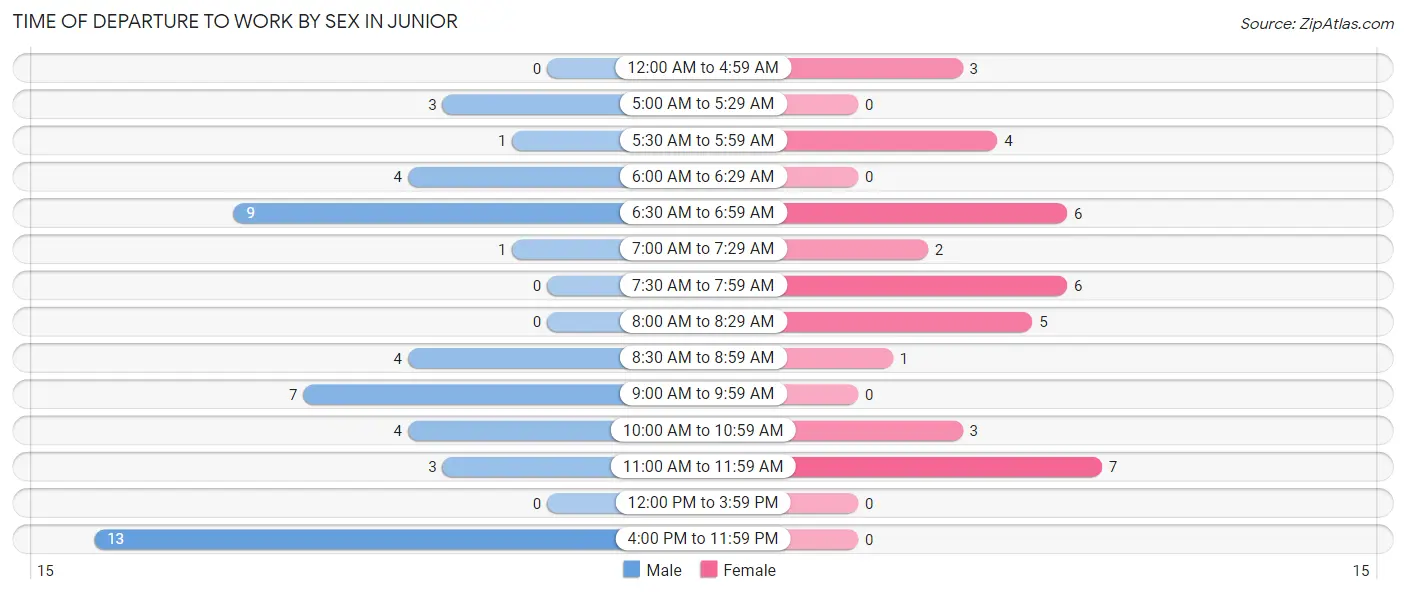
| Time of Departure | Male | Female |
| 12:00 AM to 4:59 AM | 0 (0.0%) | 3 (8.1%) |
| 5:00 AM to 5:29 AM | 3 (6.1%) | 0 (0.0%) |
| 5:30 AM to 5:59 AM | 1 (2.0%) | 4 (10.8%) |
| 6:00 AM to 6:29 AM | 4 (8.2%) | 0 (0.0%) |
| 6:30 AM to 6:59 AM | 9 (18.4%) | 6 (16.2%) |
| 7:00 AM to 7:29 AM | 1 (2.0%) | 2 (5.4%) |
| 7:30 AM to 7:59 AM | 0 (0.0%) | 6 (16.2%) |
| 8:00 AM to 8:29 AM | 0 (0.0%) | 5 (13.5%) |
| 8:30 AM to 8:59 AM | 4 (8.2%) | 1 (2.7%) |
| 9:00 AM to 9:59 AM | 7 (14.3%) | 0 (0.0%) |
| 10:00 AM to 10:59 AM | 4 (8.2%) | 3 (8.1%) |
| 11:00 AM to 11:59 AM | 3 (6.1%) | 7 (18.9%) |
| 12:00 PM to 3:59 PM | 0 (0.0%) | 0 (0.0%) |
| 4:00 PM to 11:59 PM | 13 (26.5%) | 0 (0.0%) |
| Total | 49 (100.0%) | 37 (100.0%) |
Housing Occupancy in Junior
Occupancy by Ownership in Junior
Of the total 131 dwellings in Junior, owner-occupied units account for 89 (67.9%), while renter-occupied units make up 42 (32.1%).

| Occupancy | # Housing Units | % Housing Units |
| Owner Occupied Housing Units | 89 | 67.9% |
| Renter-Occupied Housing Units | 42 | 32.1% |
| Total Occupied Housing Units | 131 | 100.0% |
Occupancy by Household Size in Junior

| Household Size | # Housing Units | % Housing Units |
| 1-Person Household | 31 | 23.7% |
| 2-Person Household | 66 | 50.4% |
| 3-Person Household | 5 | 3.8% |
| 4+ Person Household | 29 | 22.1% |
| Total Housing Units | 131 | 100.0% |
Occupancy by Ownership by Household Size in Junior

| Household Size | Owner-occupied | Renter-occupied |
| 1-Person Household | 29 (93.5%) | 2 (6.5%) |
| 2-Person Household | 45 (68.2%) | 21 (31.8%) |
| 3-Person Household | 0 (0.0%) | 5 (100.0%) |
| 4+ Person Household | 15 (51.7%) | 14 (48.3%) |
| Total Housing Units | 89 (67.9%) | 42 (32.1%) |
Occupancy by Educational Attainment in Junior

| Household Size | Owner-occupied | Renter-occupied |
| Less than High School | 12 (70.6%) | 5 (29.4%) |
| High School Diploma | 63 (70.8%) | 26 (29.2%) |
| College/Associate Degree | 14 (56.0%) | 11 (44.0%) |
| Bachelor's Degree or higher | 0 (0.0%) | 0 (0.0%) |
Occupancy by Age of Householder in Junior

| Age Bracket | # Households | % Households |
| Under 35 Years | 15 | 11.5% |
| 35 to 44 Years | 17 | 13.0% |
| 45 to 54 Years | 13 | 9.9% |
| 55 to 64 Years | 56 | 42.7% |
| 65 to 74 Years | 13 | 9.9% |
| 75 to 84 Years | 6 | 4.6% |
| 85 Years and Over | 11 | 8.4% |
| Total | 131 | 100.0% |
Housing Finances in Junior
Median Income by Occupancy in Junior

| Occupancy Type | # Households | Median Income |
| Owner-Occupied | 89 (67.9%) | $40,179 |
| Renter-Occupied | 42 (32.1%) | $13,333 |
| Average | 131 (100.0%) | $28,393 |
Occupancy by Householder Income Bracket in Junior
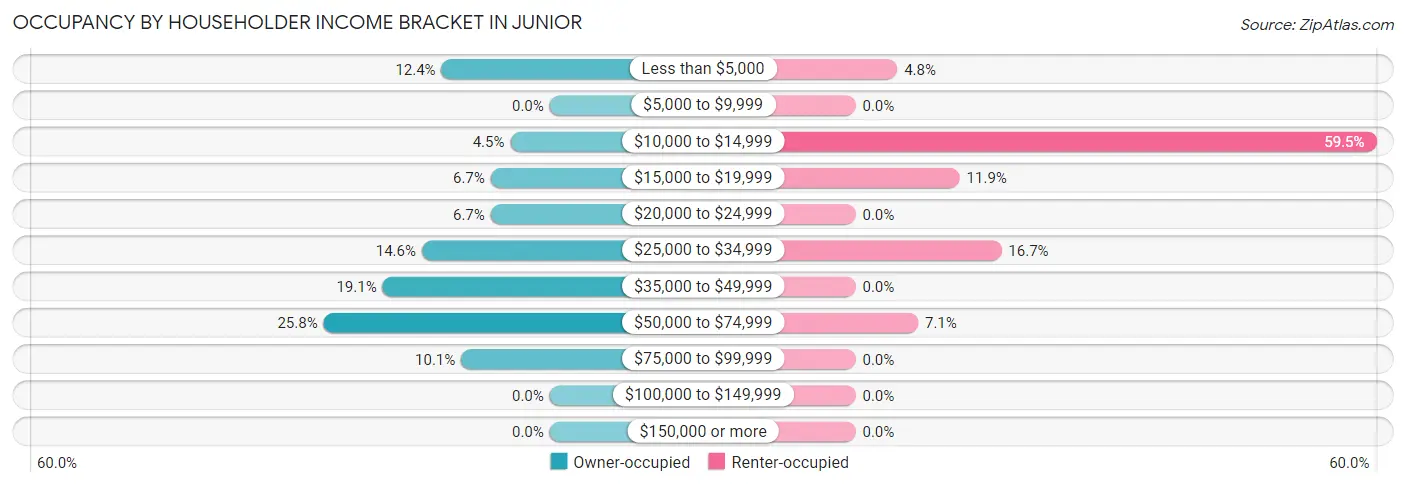
| Income Bracket | Owner-occupied | Renter-occupied |
| Less than $5,000 | 11 (12.4%) | 2 (4.8%) |
| $5,000 to $9,999 | 0 (0.0%) | 0 (0.0%) |
| $10,000 to $14,999 | 4 (4.5%) | 25 (59.5%) |
| $15,000 to $19,999 | 6 (6.7%) | 5 (11.9%) |
| $20,000 to $24,999 | 6 (6.7%) | 0 (0.0%) |
| $25,000 to $34,999 | 13 (14.6%) | 7 (16.7%) |
| $35,000 to $49,999 | 17 (19.1%) | 0 (0.0%) |
| $50,000 to $74,999 | 23 (25.8%) | 3 (7.1%) |
| $75,000 to $99,999 | 9 (10.1%) | 0 (0.0%) |
| $100,000 to $149,999 | 0 (0.0%) | 0 (0.0%) |
| $150,000 or more | 0 (0.0%) | 0 (0.0%) |
| Total | 89 (100.0%) | 42 (100.0%) |
Monthly Housing Cost Tiers in Junior

| Monthly Cost | Owner-occupied | Renter-occupied |
| Less than $300 | 33 (37.1%) | 0 (0.0%) |
| $300 to $499 | 21 (23.6%) | 2 (4.8%) |
| $500 to $799 | 20 (22.5%) | 25 (59.5%) |
| $800 to $999 | 9 (10.1%) | 3 (7.1%) |
| $1,000 to $1,499 | 4 (4.5%) | 6 (14.3%) |
| $1,500 to $1,999 | 2 (2.2%) | 0 (0.0%) |
| $2,000 to $2,499 | 0 (0.0%) | 0 (0.0%) |
| $2,500 to $2,999 | 0 (0.0%) | 0 (0.0%) |
| $3,000 or more | 0 (0.0%) | 0 (0.0%) |
| Total | 89 (100.0%) | 42 (100.0%) |
Physical Housing Characteristics in Junior
Housing Structures in Junior

| Structure Type | # Housing Units | % Housing Units |
| Single Unit, Detached | 112 | 85.5% |
| Single Unit, Attached | 0 | 0.0% |
| 2 Unit Apartments | 0 | 0.0% |
| 3 or 4 Unit Apartments | 2 | 1.5% |
| 5 to 9 Unit Apartments | 0 | 0.0% |
| 10 or more Apartments | 0 | 0.0% |
| Mobile Home / Other | 17 | 13.0% |
| Total | 131 | 100.0% |
Housing Structures by Occupancy in Junior

| Structure Type | Owner-occupied | Renter-occupied |
| Single Unit, Detached | 75 (67.0%) | 37 (33.0%) |
| Single Unit, Attached | 0 (0.0%) | 0 (0.0%) |
| 2 Unit Apartments | 0 (0.0%) | 0 (0.0%) |
| 3 or 4 Unit Apartments | 0 (0.0%) | 2 (100.0%) |
| 5 to 9 Unit Apartments | 0 (0.0%) | 0 (0.0%) |
| 10 or more Apartments | 0 (0.0%) | 0 (0.0%) |
| Mobile Home / Other | 14 (82.4%) | 3 (17.6%) |
| Total | 89 (67.9%) | 42 (32.1%) |
Housing Structures by Number of Rooms in Junior

| Number of Rooms | Owner-occupied | Renter-occupied |
| 1 Room | 0 (0.0%) | 0 (0.0%) |
| 2 or 3 Rooms | 0 (0.0%) | 0 (0.0%) |
| 4 or 5 Rooms | 28 (31.5%) | 20 (47.6%) |
| 6 or 7 Rooms | 53 (59.6%) | 15 (35.7%) |
| 8 or more Rooms | 8 (9.0%) | 7 (16.7%) |
| Total | 89 (100.0%) | 42 (100.0%) |
Housing Structure by Heating Type in Junior

| Heating Type | Owner-occupied | Renter-occupied |
| Utility Gas | 48 (53.9%) | 21 (50.0%) |
| Bottled, Tank, or LP Gas | 4 (4.5%) | 0 (0.0%) |
| Electricity | 8 (9.0%) | 18 (42.9%) |
| Fuel Oil or Kerosene | 0 (0.0%) | 3 (7.1%) |
| Coal or Coke | 8 (9.0%) | 0 (0.0%) |
| All other Fuels | 21 (23.6%) | 0 (0.0%) |
| No Fuel Used | 0 (0.0%) | 0 (0.0%) |
| Total | 89 (100.0%) | 42 (100.0%) |
Household Vehicle Usage in Junior

| Vehicles per Household | Owner-occupied | Renter-occupied |
| No Vehicle | 17 (19.1%) | 11 (26.2%) |
| 1 Vehicle | 17 (19.1%) | 24 (57.1%) |
| 2 Vehicles | 32 (36.0%) | 7 (16.7%) |
| 3 or more Vehicles | 23 (25.8%) | 0 (0.0%) |
| Total | 89 (100.0%) | 42 (100.0%) |
Real Estate & Mortgages in Junior
Real Estate and Mortgage Overview in Junior
| Characteristic | Without Mortgage | With Mortgage |
| Housing Units | 51 | 38 |
| Median Property Value | $65,000 | $73,800 |
| Median Household Income | $33,472 | $0 |
| Monthly Housing Costs | $271 | $0 |
| Real Estate Taxes | $199 | $6 |
Property Value by Mortgage Status in Junior

| Property Value | Without Mortgage | With Mortgage |
| Less than $50,000 | 20 (39.2%) | 16 (42.1%) |
| $50,000 to $99,999 | 22 (43.1%) | 12 (31.6%) |
| $100,000 to $299,999 | 9 (17.6%) | 10 (26.3%) |
| $300,000 to $499,999 | 0 (0.0%) | 0 (0.0%) |
| $500,000 to $749,999 | 0 (0.0%) | 0 (0.0%) |
| $750,000 to $999,999 | 0 (0.0%) | 0 (0.0%) |
| $1,000,000 or more | 0 (0.0%) | 0 (0.0%) |
| Total | 51 (100.0%) | 38 (100.0%) |
Household Income by Mortgage Status in Junior

| Household Income | Without Mortgage | With Mortgage |
| Less than $10,000 | 11 (21.6%) | 0 (0.0%) |
| $10,000 to $24,999 | 7 (13.7%) | 0 (0.0%) |
| $25,000 to $34,999 | 13 (25.5%) | 9 (23.7%) |
| $35,000 to $49,999 | 4 (7.8%) | 0 (0.0%) |
| $50,000 to $74,999 | 8 (15.7%) | 13 (34.2%) |
| $75,000 to $99,999 | 8 (15.7%) | 15 (39.5%) |
| $100,000 to $149,999 | 0 (0.0%) | 1 (2.6%) |
| $150,000 or more | 0 (0.0%) | 0 (0.0%) |
| Total | 51 (100.0%) | 38 (100.0%) |
Property Value to Household Income Ratio in Junior

| Value-to-Income Ratio | Without Mortgage | With Mortgage |
| Less than 2.0x | 22 (43.1%) | 46,250 (121,710.5%) |
| 2.0x to 2.9x | 5 (9.8%) | 25 (65.8%) |
| 3.0x to 3.9x | 8 (15.7%) | 11 (28.9%) |
| 4.0x or more | 16 (31.4%) | 0 (0.0%) |
| Total | 51 (100.0%) | 38 (100.0%) |
Real Estate Taxes by Mortgage Status in Junior

| Property Taxes | Without Mortgage | With Mortgage |
| Less than $800 | 41 (80.4%) | 0 (0.0%) |
| $800 to $1,499 | 2 (3.9%) | 30 (78.9%) |
| $800 to $1,499 | 0 (0.0%) | 2 (5.3%) |
| Total | 51 (100.0%) | 38 (100.0%) |
Health & Disability in Junior
Health Insurance Coverage by Age in Junior

| Age Bracket | With Coverage | Without Coverage |
| Under 6 Years | 22 (100.0%) | 0 (0.0%) |
| 6 to 18 Years | 75 (100.0%) | 0 (0.0%) |
| 19 to 25 Years | 25 (86.2%) | 4 (13.8%) |
| 26 to 34 Years | 23 (100.0%) | 0 (0.0%) |
| 35 to 44 Years | 30 (83.3%) | 6 (16.7%) |
| 45 to 54 Years | 35 (89.7%) | 4 (10.3%) |
| 55 to 64 Years | 80 (98.8%) | 1 (1.2%) |
| 65 to 74 Years | 27 (100.0%) | 0 (0.0%) |
| 75 Years and older | 20 (100.0%) | 0 (0.0%) |
| Total | 337 (95.7%) | 15 (4.3%) |
Health Insurance Coverage by Citizenship Status in Junior

| Citizenship Status | With Coverage | Without Coverage |
| Native Born | 22 (100.0%) | 0 (0.0%) |
| Foreign Born, Citizen | 75 (100.0%) | 0 (0.0%) |
| Foreign Born, not a Citizen | 25 (86.2%) | 4 (13.8%) |
Health Insurance Coverage by Household Income in Junior

| Household Income | With Coverage | Without Coverage |
| Under $25,000 | 106 (96.4%) | 4 (3.6%) |
| $25,000 to $49,999 | 151 (96.8%) | 5 (3.2%) |
| $50,000 to $74,999 | 52 (89.7%) | 6 (10.3%) |
| $75,000 to $99,999 | 28 (100.0%) | 0 (0.0%) |
| $100,000 and over | 0 (0.0%) | 0 (0.0%) |
Public vs Private Health Insurance Coverage by Age in Junior

| Age Bracket | Public Insurance | Private Insurance |
| Under 6 | 15 (68.2%) | 7 (31.8%) |
| 6 to 18 Years | 54 (72.0%) | 26 (34.7%) |
| 19 to 25 Years | 16 (55.2%) | 9 (31.0%) |
| 25 to 34 Years | 19 (82.6%) | 4 (17.4%) |
| 35 to 44 Years | 17 (47.2%) | 14 (38.9%) |
| 45 to 54 Years | 24 (61.5%) | 11 (28.2%) |
| 55 to 64 Years | 62 (76.5%) | 20 (24.7%) |
| 65 to 74 Years | 27 (100.0%) | 11 (40.7%) |
| 75 Years and over | 20 (100.0%) | 2 (10.0%) |
| Total | 254 (72.2%) | 104 (29.5%) |
Disability Status by Sex by Age in Junior

| Age Bracket | Male | Female |
| Under 5 Years | 0 (0.0%) | 0 (0.0%) |
| 5 to 17 Years | 2 (4.3%) | 0 (0.0%) |
| 18 to 34 Years | 8 (20.0%) | 3 (21.4%) |
| 35 to 64 Years | 10 (13.9%) | 30 (35.7%) |
| 65 to 74 Years | 0 (0.0%) | 5 (45.5%) |
| 75 Years and over | 4 (33.3%) | 2 (25.0%) |
Disability Class by Sex by Age in Junior
Disability Class: Hearing Difficulty

| Age Bracket | Male | Female |
| Under 5 Years | 0 (0.0%) | 0 (0.0%) |
| 5 to 17 Years | 0 (0.0%) | 0 (0.0%) |
| 18 to 34 Years | 0 (0.0%) | 0 (0.0%) |
| 35 to 64 Years | 3 (4.2%) | 4 (4.8%) |
| 65 to 74 Years | 0 (0.0%) | 0 (0.0%) |
| 75 Years and over | 2 (16.7%) | 2 (25.0%) |
Disability Class: Vision Difficulty

| Age Bracket | Male | Female |
| Under 5 Years | 0 (0.0%) | 0 (0.0%) |
| 5 to 17 Years | 0 (0.0%) | 0 (0.0%) |
| 18 to 34 Years | 0 (0.0%) | 0 (0.0%) |
| 35 to 64 Years | 3 (4.2%) | 1 (1.2%) |
| 65 to 74 Years | 0 (0.0%) | 0 (0.0%) |
| 75 Years and over | 0 (0.0%) | 0 (0.0%) |
Disability Class: Cognitive Difficulty

| Age Bracket | Male | Female |
| 5 to 17 Years | 2 (4.3%) | 0 (0.0%) |
| 18 to 34 Years | 8 (20.0%) | 0 (0.0%) |
| 35 to 64 Years | 0 (0.0%) | 11 (13.1%) |
| 65 to 74 Years | 0 (0.0%) | 1 (9.1%) |
| 75 Years and over | 0 (0.0%) | 0 (0.0%) |
Disability Class: Ambulatory Difficulty

| Age Bracket | Male | Female |
| 5 to 17 Years | 0 (0.0%) | 0 (0.0%) |
| 18 to 34 Years | 8 (20.0%) | 3 (21.4%) |
| 35 to 64 Years | 8 (11.1%) | 20 (23.8%) |
| 65 to 74 Years | 0 (0.0%) | 4 (36.4%) |
| 75 Years and over | 3 (25.0%) | 2 (25.0%) |
Disability Class: Self-Care Difficulty

| Age Bracket | Male | Female |
| 5 to 17 Years | 0 (0.0%) | 0 (0.0%) |
| 18 to 34 Years | 8 (20.0%) | 0 (0.0%) |
| 35 to 64 Years | 0 (0.0%) | 13 (15.5%) |
| 65 to 74 Years | 0 (0.0%) | 3 (27.3%) |
| 75 Years and over | 0 (0.0%) | 2 (25.0%) |
Technology Access in Junior
Computing Device Access in Junior

| Device Type | # Households | % Households |
| Desktop or Laptop | 71 | 54.2% |
| Smartphone | 84 | 64.1% |
| Tablet | 65 | 49.6% |
| No Computing Device | 27 | 20.6% |
| Total | 131 | 100.0% |
Internet Access in Junior

| Internet Type | # Households | % Households |
| Dial-Up Internet | 3 | 2.3% |
| Broadband Home | 83 | 63.4% |
| Cellular Data Only | 10 | 7.6% |
| Satellite Internet | 3 | 2.3% |
| No Internet | 33 | 25.2% |
| Total | 131 | 100.0% |
Junior Summary
WV History
West Virginia is a state located in the Appalachian region of the Southern United States. It was admitted to the Union on June 20, 1863, becoming the 35th state. West Virginia was originally part of the state of Virginia, but it seceded from the state during the American Civil War. The state was formed from the western counties of Virginia, which were largely pro-Union and anti-slavery.
West Virginia has a rich history that dates back to the early 1700s. The first settlers in the area were Native Americans, who were followed by European settlers in the late 1700s. The state was part of the Commonwealth of Virginia until the Civil War, when it seceded and became its own state.
During the Civil War, West Virginia was a major battleground. The state was the site of several major battles, including the Battle of Antietam and the Battle of Gettysburg. After the war, West Virginia was admitted to the Union and became a major industrial center. The state was home to several major industries, including coal mining, steel production, and timber production.
West Virginia has also played an important role in American politics. The state was the birthplace of two presidents, Woodrow Wilson and John F. Kennedy. West Virginia was also the site of the first primary election in the United States, which was held in 1916.
Geography
West Virginia is located in the Appalachian region of the United States. It is bordered by Pennsylvania to the north, Maryland to the east, Virginia to the south, and Ohio to the west. The state has a total area of 24,230 square miles, making it the 41st largest state in the country.
West Virginia is divided into two distinct regions: the Allegheny Plateau and the Appalachian Mountains. The Allegheny Plateau is located in the western part of the state and is characterized by rolling hills and valleys. The Appalachian Mountains are located in the eastern part of the state and are characterized by steep, rugged terrain.
The highest point in West Virginia is Spruce Knob, which is located in the Allegheny Mountains and has an elevation of 4,863 feet. The lowest point in the state is the Potomac River, which has an elevation of 240 feet.
Economy
West Virginia has a diverse economy that is largely based on natural resources. The state is a major producer of coal, natural gas, and timber. It is also a major producer of chemicals, steel, and aluminum.
West Virginia is also home to several major industries, including tourism, manufacturing, and healthcare. The state is home to several major universities, including West Virginia University and Marshall University.
The state’s economy has been in decline since the 1980s, due to the decline of the coal industry and the loss of manufacturing jobs. However, the state has seen some economic growth in recent years, due to the growth of the tourism industry and the expansion of the healthcare sector.
Demographics
West Virginia has a population of 1.8 million people, making it the 38th most populous state in the country. The state has a population density of 77 people per square mile, making it the 41st most densely populated state in the country.
The racial makeup of West Virginia is 92.2% White, 4.2% Black or African American, 0.7% Asian, 0.2% Native American, and 2.7% from two or more races. The state has a median household income of $45,890, which is lower than the national median of $60,293.
West Virginia is home to several major cities, including Charleston, Huntington, and Parkersburg. The state capital is Charleston, which is also the largest city in the state.
Common Questions
What is Per Capita Income in Junior?
Per Capita income in Junior is $13,563.
What is the Median Family Income in Junior?
Median Family Income in Junior is $29,464.
What is the Median Household income in Junior?
Median Household Income in Junior is $28,393.
What is Family Income Deficit in Junior?
Family Income Deficit in Junior is $9,326.
Families that are below poverty line in Junior earn $9,326 less on average than the poverty threshold level.
What is Inequality or Gini Index in Junior?
Inequality or Gini Index in Junior is 0.40.
What is the Total Population of Junior?
Total Population of Junior is 352.
What is the Total Male Population of Junior?
Total Male Population of Junior is 198.
What is the Total Female Population of Junior?
Total Female Population of Junior is 154.
What is the Ratio of Males per 100 Females in Junior?
There are 128.57 Males per 100 Females in Junior.
What is the Ratio of Females per 100 Males in Junior?
There are 77.78 Females per 100 Males in Junior.
What is the Median Population Age in Junior?
Median Population Age in Junior is 43.5 Years.
What is the Average Family Size in Junior
Average Family Size in Junior is 3.1 People.
What is the Average Household Size in Junior
Average Household Size in Junior is 2.7 People.
How Large is the Labor Force in Junior?
There are 119 People in the Labor Forcein in Junior.
What is the Percentage of People in the Labor Force in Junior?
44.6% of People are in the Labor Force in Junior.
What is the Unemployment Rate in Junior?
Unemployment Rate in Junior is 27.7%.